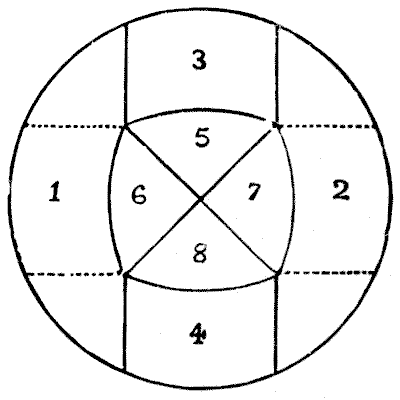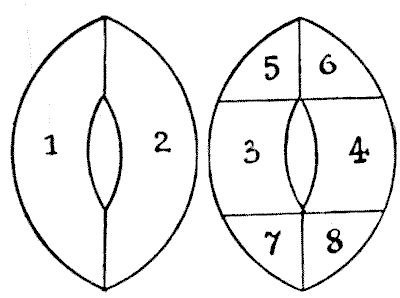
THE TABLE-TOP AND STOOLS.—solution

One object that I had in view when presenting this little puzzle was to point out the uncertainty of the meaning conveyed by the word "oval." Though originally derived from the Latin word ovum, an egg, yet what we understand as the egg-shape (with one end smaller than the other) is only one of many forms of the oval; while some eggs are spherical in shape, and a sphere or circle is most certainly not an oval. If we speak of an ellipse—a conical ellipse—we are on safer ground, but here we must be careful of error. I recollect a Liverpool town councillor, many years ago, whose ignorance of the poultry-yard led him to substitute the word "hen" for "fowl," remarking, "We must remember, gentlemen, that although every cock is a hen, every hen is not a cock!" Similarly, we must always note that although every ellipse is an oval, every oval is not an ellipse. It is correct to say that an oval is an oblong curvilinear figure, having two unequal diameters, and bounded by a curve line returning into itself; and this includes the ellipse, but all other figures which in any way approach towards the form of an oval without necessarily having the properties above described are included in the term "oval." Thus the following solution that I give to our puzzle involves the pointed "oval," known among architects as the "vesica piscis."

The dotted lines in the table are given for greater clearness, the cuts being made along the other lines. It will be seen that the eight pieces form two stools of exactly the same size and shape with similar hand-holes. These holes are a trifle longer than those in the schoolmaster's stools, but they are much narrower and of considerably smaller area. Of course 5 and 6 can be cut out in one piece—also 7 and 8—making only six pieces in all. But I wished to keep the same number as in the original story.
When I first gave the above puzzle in a London newspaper, in competition, no correct solution was received, but an ingenious and neatly executed attempt by a man lying in a London infirmary was accompanied by the following note: "Having no compasses here, I was compelled to improvise a pair with the aid of a small penknife, a bit of firewood from a bundle, a piece of tin from a toy engine, a tin tack, and two portions of a hairpin, for points. They are a fairly serviceable pair of compasses, and I shall keep them as a memento of your puzzle."
click here to go to my blog.
See more interesting puzzles at http://puzzles.50webs.org